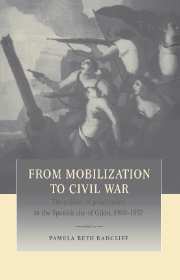Book contents
- Frontmatter
- Contents
- List of maps
- List of tables
- Acknowledgments
- Glossary of terms and abbreviations
- Introduction
- 1 A turning point: the city in 1900
- PART I Patterns of life in working-class Gijón
- PART II Institutional forces of opposition: republicans and anarchosyndicalists
- PART III Defining an oppositional culture: the struggle over the public sphere
- PART IV The urban battlefield: conflict and collective action, 1901–1936
- Conclusion
- Appendix 1 Wage and price movement
- Appendix 2 Occupations by status category
- Appendix 3 Supplementary tables
- Select bibliography
- Index
PART III - Defining an oppositional culture: the struggle over the public sphere
Published online by Cambridge University Press: 31 October 2009
- Frontmatter
- Contents
- List of maps
- List of tables
- Acknowledgments
- Glossary of terms and abbreviations
- Introduction
- 1 A turning point: the city in 1900
- PART I Patterns of life in working-class Gijón
- PART II Institutional forces of opposition: republicans and anarchosyndicalists
- PART III Defining an oppositional culture: the struggle over the public sphere
- PART IV The urban battlefield: conflict and collective action, 1901–1936
- Conclusion
- Appendix 1 Wage and price movement
- Appendix 2 Occupations by status category
- Appendix 3 Supplementary tables
- Select bibliography
- Index
Summary
The struggle to define an oppositional movement that could tear down the fabric of the old regime extended beyond the realm of formal political and economic institutions and into the broader domain of the public sphere, where the limits of hegemony are tested. Outside the coercive structures of formal political and economic control, the public sphere provided a relatively open space of contention, where the ruling elites had to demonstrate their claim to moral and intellectual leadership and win the consent that marks the distinction between hegemony and domination. Once Gijón began to develop the infrastructure of a thriving public sphere, with its institutions and networks of voluntary associational life, contending forces tried to shape and channel this associational life, to “structure attention” towards their own hegemonic agendas. Thus, the public sphere developed as the central arena in which the competing systems of power fought for legitimation.
As all the contending forces seemed to understand, successful legitimation depended on the reflexive acceptance of a universe of cultural values and practices that situated the population in a broad hegemonic framework of authority. Thus, both the republican and labor movements perceived that their assault on the old regime required the destruction of a traditional cultural universe in which most Spaniards were still embedded in 1900. To undermine this world view, republicans and trade unionists each sought to create an alternative, counter-hegemonic culture that would both displace the existing one and prepare the humble residents of “smoke-filled” Gijón to participate in the future society as they imagined it.
- Type
- Chapter
- Information
- From Mobilization to Civil WarThe Politics of Polarization in the Spanish City of Gijón, 1900–1937, pp. 195 - 198Publisher: Cambridge University PressPrint publication year: 1997



